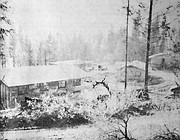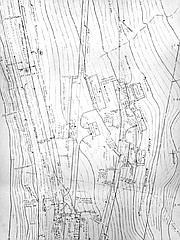Canoe Gulch anniversary marks past generations
With 50 years and still “plugging along,” the Canoe Gulch Ranger Station continues to help protect and sustain the surrounding Kootenai Forest.
While the headquarters of the Libby Ranger District at Canoe Gulch still features all the original structures, the station has evolved through the years.
Comparing the original Army Corps of Engineer’s plans from 1966 to the district today, all of the original structures still stand, with a few functions allocated between the buildings. The current Vegetation Management building and the Technical Management building both used to be dormitories, and the Fire and IRM building was used as the cookhouse.
“In this forest, I think it’s the only compound we have that is still 100 percent original,” Heritage Program Manager Forest Archeologist Justin Moschelle said. “So it’s kind of a unique thing.”
The Army Corps of Engineers built the new Canoe Gulch District in the place of the Warren District, which was flooded in the 1970s, along with the towns of Rexford, Marston, Jennings, Ural, Warland and Stone Hill after the construction of the Libby Dam.
The $600,000 project involved moving the Warland District to present-day Canoe Gulch off of MT Highway 37 in 1966, where the plans were drawn and ground was broken.
The Army Corps of Engineers paid for the entire construction and did all of the engineering drawing based off of a memorandum agreement between the Department of War and the Department of Agriculture.
The station has seen many conversions since 1966 from the St. Regis Lumber Company, Champion Timber Company, Plum Creek Timber Company to the Weyerhaeuser Timber Company. The year the station was built was the year J. Neils Lumber Company merged with St. Regis.
According to the Canoe Gulch District Supervisor Nate Gassmann, in recent years the district has worked on the east reservoir management, ski and snowmobile trails, timber sales and worked with volunteers in the area on redoing and improving the running of cabins and lookouts.
The district has also recently developed a new forest plan in 2015, according to Gassmann. The plan includes maps and opportunities with trails and overarching ways to manage the trails, which is important for future generations, Gassmann said.
“Through all of the transitions of people and companies, the Canoe Gulch has been plugging along,” Gassmann said. “A lot of different people come and go...it’s been an evolutionary process...how those things have changed over time has been neat to watch.”
The district has seen many people come and go through the doors of the district, including Leanne Martin, the regional forester for the Forest Service’s Northern Region which altogether encompasses 25 million acres of public land and includes natural forests of Montana, north Idaho, the northwestern corner of South Dakota and the national grasslands in North Dakota.
Martin’s first permanent position with the Forest Service upon graduating from college was at Canoe Gulch.
“I have fond memories of working in northern Montana and it will always hold a special place in my heart,” said Marten in an email. “What a beautiful place to begin my career. The community and my fellow coworkers gave me a good foundation from which to establish an ethic of caring for the land and serving people.”
With a new forest plan and the district’s contributions to the community over the last 50 years, the district continues to preserve diversity and maintain sustainability to provide future generations with the forest’s aesthetics and resources.
Reporter Bethany Rolfson may be reached at 293-4124 or by email at Reporter@TheWesternNews.com.





